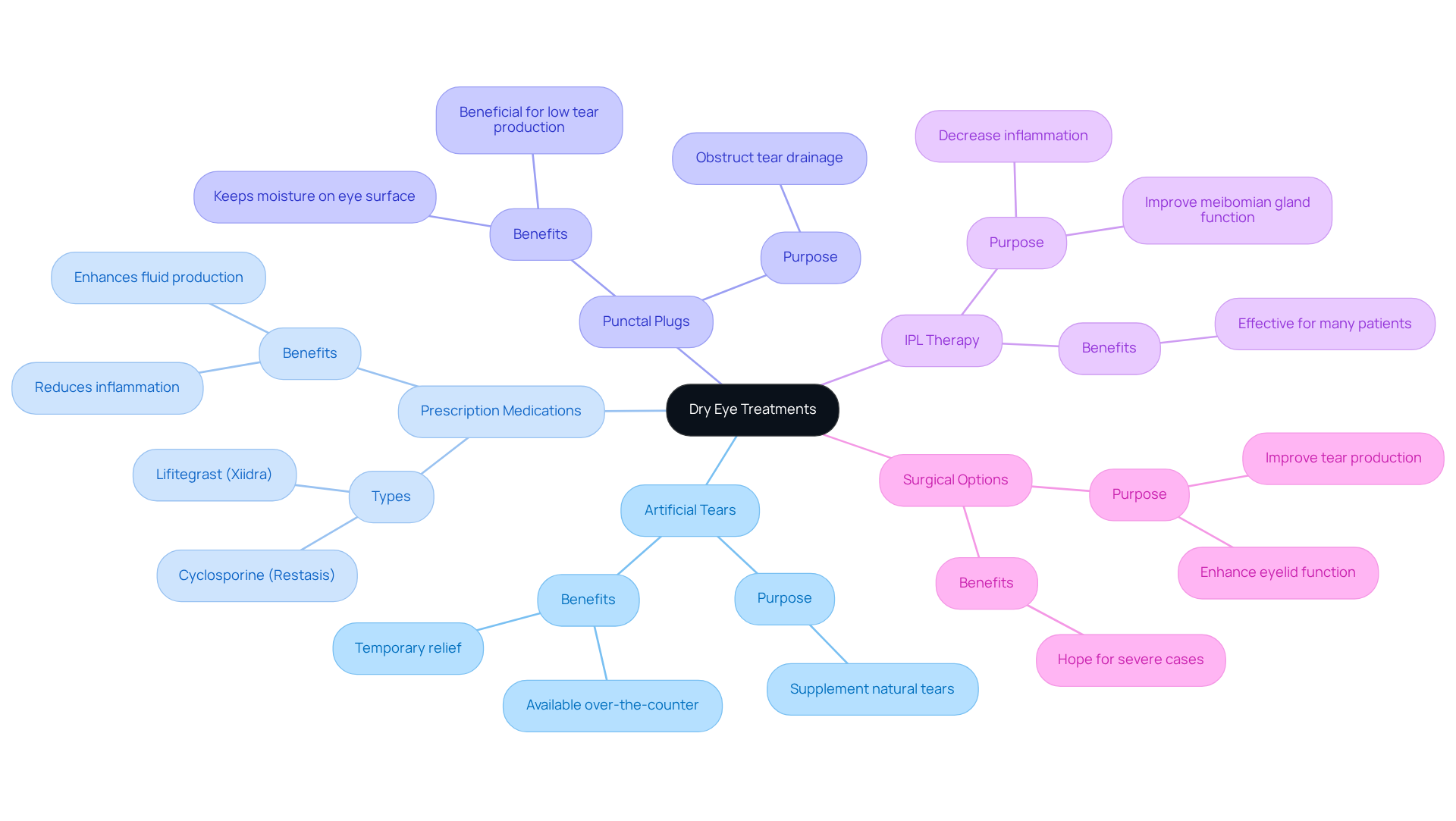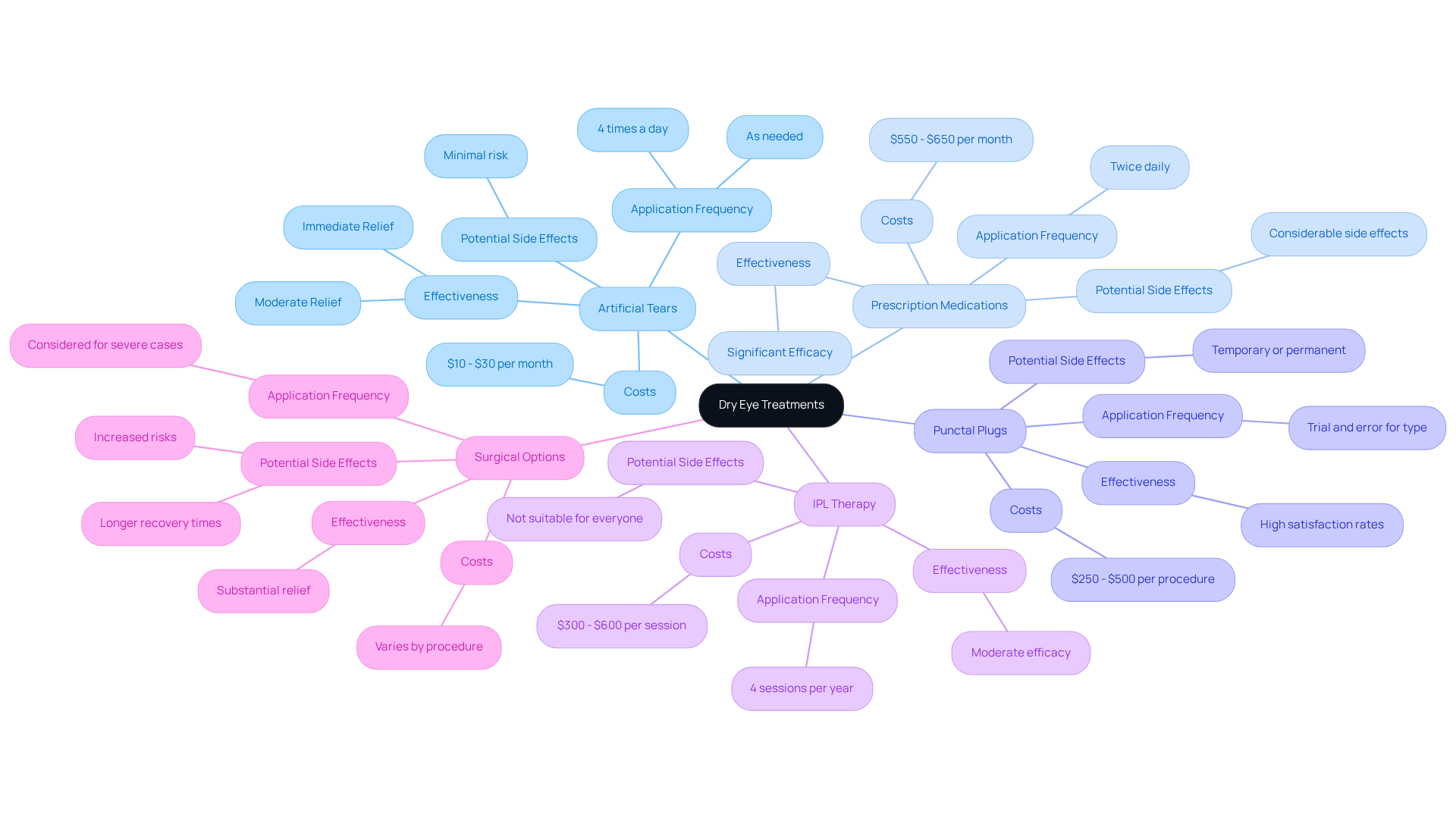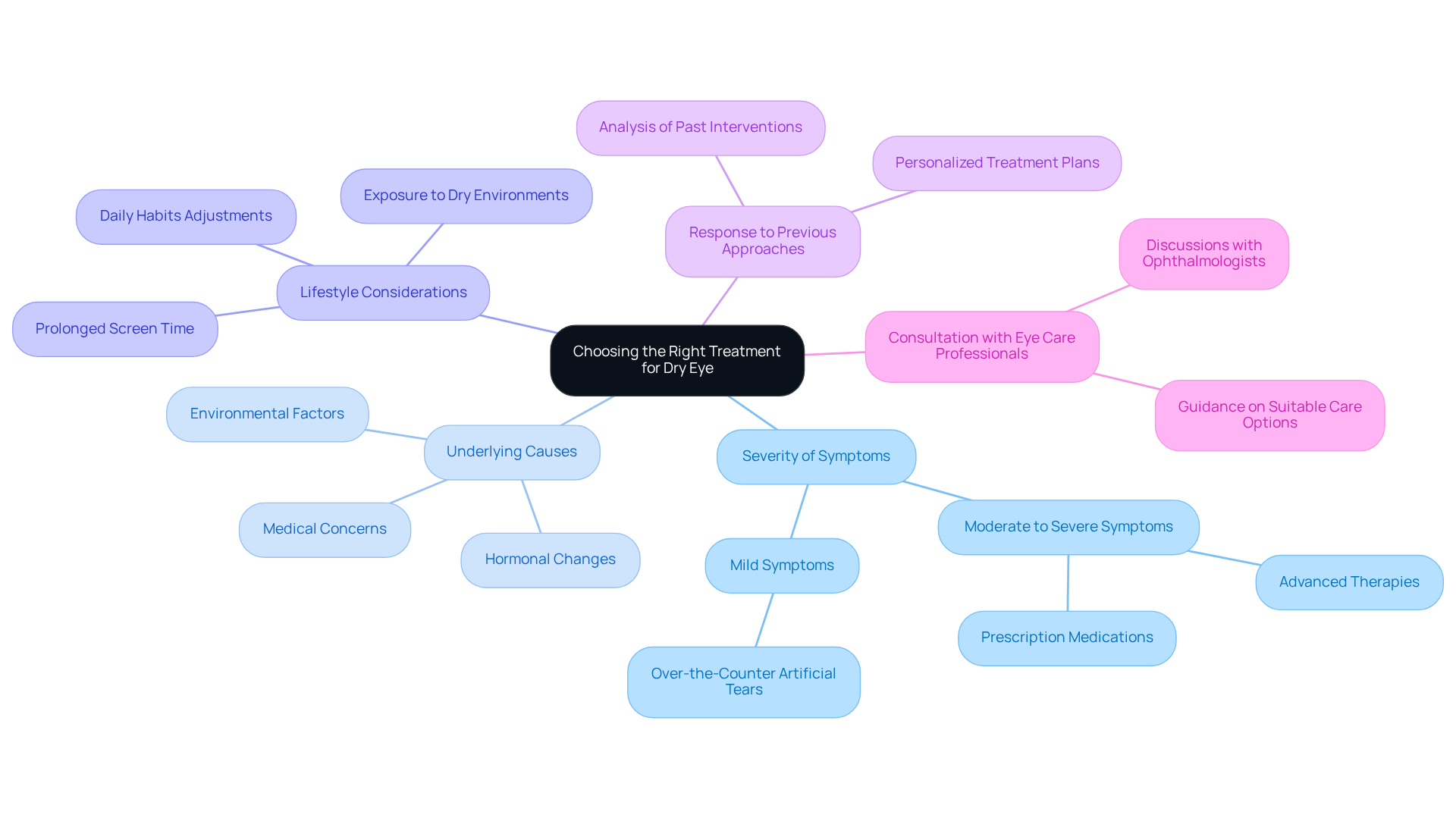Posted by: Northwest Eye in General on July 23, 2025
Overview
We understand that dealing with Dry Eye Syndrome (DES) can be challenging and frustrating. This article explores various treatment options available to you, including:
- Artificial tears
- Prescription medications
- Punctal plugs
- Intense pulsed light therapy
- Surgical options
It’s important to know that the right choice of treatment is not one-size-fits-all.
Your treatment should be personalized, taking into account the severity of your symptoms, any underlying causes, your lifestyle, and how you have responded to previous therapies. We are here to help you through this process, ensuring that you receive the most suitable care tailored to your individual needs.
Remember, you’re not alone in this journey. Many patients have successfully navigated their treatment options, and we encourage you to reach out for support and guidance as you explore the best path forward for your eye health.
Introduction
Dry Eye Syndrome (DES) impacts millions of individuals, often leading to discomfort and frustration as they navigate the challenges of insufficient tear production or poor fluid quality. We understand that facing such a condition can feel overwhelming.
With numerous treatment options available—from artificial tears to advanced therapies like Intense Pulsed Light (IPL)—it can be daunting to find the right path to relief. How do you determine the most effective approach amidst such variety, especially when considering your unique symptoms and underlying causes?
This article aims to provide a comparative analysis of DES treatments, offering insights into their effectiveness and suitability. Our goal is to empower you to make informed decisions for your eye health, ensuring that you feel supported throughout this journey.
Understanding Dry Eye Syndrome: Causes and Symptoms
Syndrome (DES) is a common condition that many people experience, characterized by insufficient fluid production or poor fluid quality. This can lead to inflammation and harm to the ocular surface. We understand that this condition can be frustrating and uncomfortable. The primary contributors to this syndrome include:
- Aging: As we age, tear production tends to diminish, which can increase susceptibility to dry eye. Studies indicate a 5-year incidence of 13.3% among older adults, highlighting the importance of awareness.
- Hormonal Changes: Hormonal fluctuations, particularly during menopause, can significantly impact tear production, leading to increased dryness.
- Environmental Factors: Exposure to elements such as wind, smoke, and extended screen time can worsen symptoms, emphasizing the need for protective measures.
- Medical Conditions: Autoimmune disorders like Sjögren’s syndrome and certain medications, including antihistamines and diuretics, are known to exacerbate dry eye symptoms.
include a stinging or burning sensation, redness, blurred vision, and a gritty feeling in the eyes. It’s essential to identify these symptoms to seek suitable . Ophthalmologists emphasize that excessive tearing can also indicate dry eye, as it often results from a lack of lubrication. We want you to know that empowers you to seek timely medical intervention, ultimately improving your quality of life.
At Northwest Eye, we take a comprehensive approach to assessing dry eye, employing such as LipiView®, Tear Osmolarity, and RPS InflammaDry to evaluate fluid quality and inflammation levels. This thorough evaluation ensures that you receive , which may include dry eye syndrome treatments such as LipiFlow®, Restasis®, and artificial solutions, among others.
Additionally, the is significant, with direct medical costs in the United States for evaluating and treating dry eye exceeding $3.8 billion annually. Furthermore, we know that up to 30% impairment in work performance (presenteeism) among individuals dealing with persistent dryness highlights the broader implications of this condition on daily life. While many patients depend on , studies indicate that only around 37% consider them adequate for prolonged relief. and the Salisbury eye evaluation can aid in assessing symptoms, helping you better understand your condition. As Scot E. Moss notes, “The is substantial. However, there are few associated risk factors,” underscoring the importance of awareness and proactive management. We are here to help you through this process.

Overview of Dry Eye Treatments: Types and Approaches
We understand that dealing with dry eyes can be uncomfortable and frustrating. Fortunately, there are several treatment options available to help you find relief:
- : These offer temporary relief by supplementing your natural tears, helping to soothe your eyes.
- : For those needing more support, like anti-inflammatory drops such as cyclosporine (Restasis) and lifitegrast (Xiidra) can and reduce inflammation, providing a more lasting solution.
- Punctal Plugs: These small devices are utilized in dry eye syndrome treatments by being placed into the drainage ducts to obstruct flow, keeping for an extended period. This can be particularly beneficial if you struggle with tear production.
- : A newer method, IPL therapy uses light pulses to decrease inflammation and improve meibomian gland function, which is one of the primary approaches among dry eye syndrome treatments. Many patients find this approach to be effective.
- Surgical Options: In severe cases, to improve tear production or eyelid function, offering hope for those who have not found relief through other means.
Each of these dry eye syndrome treatments comes with its own indications, benefits, and limitations. It’s essential to to determine the best approach tailored to your needs. Remember, we are here to help you through this process and support you in finding the relief you deserve.

Comparative Analysis of Dry Eye Treatments: Effectiveness and Suitability
When evaluating , we understand that it can be a challenging experience. Several key options emerge, each with distinct benefits and considerations that may resonate with your situation:
- : Typically, these are the first line of defense for mild dry eye cases, offering immediate relief. Cooled synthetic drops at 4°C are recognized as the most pleasant temperature for minimizing corneal and conjunctival sensation. However, we acknowledge that they require frequent application and do not address the underlying causes of dryness.
- : For those dealing with moderate to severe dry eye, prescription options, such as Varenicline (Tyrvaya®), approved by the FDA in 2021 to boost fluid production, have shown significant efficacy in enhancing fluid production and alleviating symptoms. While they may take several weeks to yield noticeable results, their effectiveness is well-documented. It’s important to consider potential side effects as part of your decision-making process.
- : If you find that synthetic drops or medications aren’t providing sufficient relief, punctal plugs may be a helpful option. These devices, which can be temporary or permanent, function by obstructing the drainage ducts, thereby retaining moisture on the ocular surface for extended durations. Many patients report high satisfaction rates with punctal plugs, especially those experiencing chronic dryness. It may take some trial and error to determine the most suitable type for your needs, with costs typically ranging from $250 to $500 per procedure.
- : This emerging method involves delivering pulses of broad-spectrum light to the skin around the eyes and has garnered positive feedback from patients, particularly those with meibomian gland dysfunction. This non-invasive procedure can provide lasting relief, though it may not be appropriate for everyone.
- Surgical Options: Reserved for severe cases, , such as thermal cautery that permanently seals tear ducts, can offer substantial relief. However, we recognize that these come with increased risks and longer recovery times. Such choices are generally considered when other methods have not succeeded.
In summary, we believe that the choice of dry eye syndrome treatments should be personalized. It’s essential to consider your specific symptoms, the severity of your condition, and your responses to previous therapies. This tailored approach ensures the for managing dry eye syndrome, and we are here to help you through this process.

Choosing the Right Treatment: Factors to Consider for Individual Needs
Selecting the appropriate involves careful consideration of several critical factors. We understand that can be frustrating, and knowing your options is essential.
- Severity of Symptoms: Patients with mild symptoms often find relief with over-the-counter artificial tears. However, if you are experiencing moderate to severe symptoms, prescription medications or advanced therapies may be necessary to help you feel better.
- Underlying Causes: —whether they arise from environmental factors, hormonal changes, or particular medical concerns—can greatly impact your care decisions. It’s common to feel overwhelmed by these factors, but recognizing them is a crucial step toward relief.
- Lifestyle Considerations: Daily habits, such as , play a crucial role in the effectiveness of your care. Adjusting these factors can enhance the outcomes of your chosen therapies, and we are here to support you in making those changes.
- Response to Previous Approaches: can aid in personalizing your future treatment plans. This ensures that you receive the most effective measures tailored to your needs.
- : Engaging in thorough discussions with ophthalmologists or optometrists is essential. Their expertise can guide you toward the most suitable care options tailored to your individual circumstances.
A that encompasses these considerations not only improves the management of dry eye syndrome treatments but also enhances your overall quality of life. Remember, we are here to help you through this process, and together, we can find the best path forward.

Conclusion
Understanding and managing Dry Eye Syndrome is crucial for improving your quality of life and alleviating discomfort. This article has highlighted the multifaceted nature of this condition, emphasizing the importance of recognizing its causes, symptoms, and the variety of treatment options available. From artificial tears to advanced therapies like Intense Pulsed Light (IPL) and surgical interventions, each treatment offers unique benefits tailored to your individual needs.
We understand that navigating this journey can be overwhelming. Key insights shared include:
- The significance of personalized treatment approaches
- Considering factors such as symptom severity
- Underlying causes
- Lifestyle influences
Consulting with eye care professionals is vital for developing a comprehensive management plan that effectively addresses your specific conditions. The economic burden and impact on daily life further underscore the necessity of proactive care and awareness in managing Dry Eye Syndrome.
Ultimately, taking charge of your eye health is essential. If you are experiencing symptoms of dry eye, we encourage you to seek timely evaluation and explore the array of treatment options available. By doing so, you can find relief and enhance your overall well-being, paving the way for a more comfortable and fulfilling life.
Frequently Asked Questions
What is Dry Eye Syndrome (DES)?
Dry Eye Syndrome is a common condition characterized by insufficient tear production or poor tear quality, leading to inflammation and damage to the ocular surface.
What are the primary causes of Dry Eye Syndrome?
The primary causes include aging, hormonal changes (especially during menopause), environmental factors (such as wind, smoke, and prolonged screen time), and certain medical conditions or medications that can exacerbate symptoms.
What are common symptoms of Dry Eye Syndrome?
Common symptoms include a stinging or burning sensation, redness, blurred vision, and a gritty feeling in the eyes. Excessive tearing can also indicate dry eye, as it results from a lack of lubrication.
How is Dry Eye Syndrome diagnosed?
Diagnosis involves advanced testing techniques such as LipiView®, Tear Osmolarity, and RPS InflammaDry to evaluate fluid quality and inflammation levels.
What treatments are available for Dry Eye Syndrome?
Treatments may include LipiFlow®, Restasis®, and artificial tears, among others, tailored to individual needs based on a comprehensive assessment.
What is the economic impact of Dry Eye Syndrome?
The direct medical costs for evaluating and treating dry eye in the United States exceed $3.8 billion annually, and individuals may experience up to a 30% impairment in work performance due to persistent dryness.
How can I assess my symptoms related to Dry Eye Syndrome?
Tools like the Bjerrum questionnaire and the Salisbury eye evaluation can help assess symptoms and provide a better understanding of your condition.
Why is awareness of Dry Eye Syndrome important?
Understanding the symptoms and risk factors of dry eye is crucial for seeking timely medical intervention and improving quality of life.






